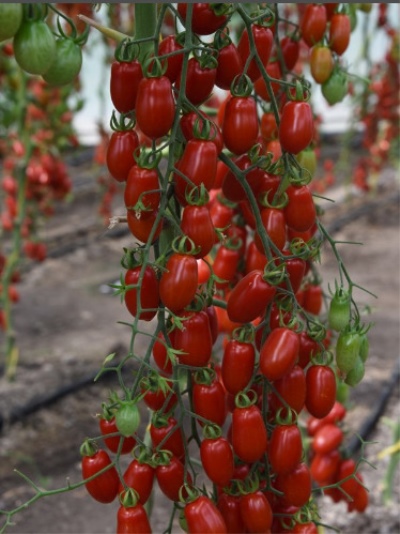
- Authors: Khovrin A.N., Tereshonkova T.A., Klimenko N.N., Kostenko A.N.
- Year of approval: 2015
- Category: hybrid
- Growth type: indeterminate
- Appointment: fresh consumption
- Ripening period: early
- Ripening time, days: 95-100
- Growing conditions: for closed ground
- Marketability: high
- Bush size: tall
Tomato Sweet Fountain is an indeterminate, early ripening hybrid. It is very popular among vegetable growers, and this is not surprising. This variety grows well in greenhouse conditions and, with proper care, gives a large yield. Its fruits will delight you with a wonderful taste and pleasant texture.
Description of the variety
Tomato Sweet Fountain belongs to indeterminate varieties, intended for cultivation in a greenhouse and is distinguished by abundant fruiting. The bushes are characterized by strong vegetation. They can be up to 2 m in height. As it grows, the plant requires shaping and garters.
Growing the variety Sweet Fountain F1 in the open field is impossible. The hybrid is extremely sensitive and unable to withstand even a slight drop in temperature.
The main qualities of the fruit
The Sweet Fountain variety belongs to cherry tomatoes. Tomatoes are not large in size. The weight of each of them is from 18 to 20 g, and the size is only 2.8 by 2 cm.
Ripe fruits are colored in a bright shade of red. They can be oval or elliptical. The tomatoes are covered with a smooth medium skin.
High transportability of fruits and good keeping quality allows growing them not only for personal purposes, but also for further sale.
Taste characteristics
The ripe fruits of this variety are distinguished by an excellent dessert sweet taste. This feature makes the variety unique and allows the use of tomatoes both for fresh consumption and for canning. Due to their pleasant taste, tomatoes of this variety are often used for preparing fresh salads and decorating dishes.
Ripening and fruiting
The Sweet Fountain hybrid belongs to the early maturing varieties. The first fruits can be seen 95-100 days after the first shoots appear. From 16 to 30 berries appear on one brush, which indicates the abundant fruiting of the bushes.
Yield
The Sweet Fountain hybrid belongs to high-yielding varieties. With proper care and a sufficient amount of nutrients in the soil, up to 7 kg of ripe fruits can be harvested from 1 square meter. The first ripe berries are harvested by summer residents in early July.
The timing of planting seedlings and planting in the ground
When sowing and transplanting seedlings to a permanent place of growth, planting dates should be observed. The optimal period for sowing seeds for seedlings is the beginning of March.
Transplanting seedlings to a permanent place of growth, as a rule, is carried out in May. However, in some cases, it may be delayed for 1-2 weeks.

Growing tomato seedlings is an extremely important process, because it largely depends on whether the gardener will be able to harvest at all. All aspects must be taken into account, from seedbed preparation to planting in the ground.
Landing scheme
For normal growth and proper development of the bushes, when planting seedlings, you should adhere to the recommended scheme. The distance between the bushes should be from 40 to 60 cm, and between the rows - 60-70 cm.

Growing and care
To get the maximum amount of the crop, you should adhere to some rules for growing the variety. Given the weak resistance of the hybrid to sudden changes in temperature conditions, the Sweet Fountain tomatoes should be grown using the seedling method.
Sowing is carried out according to the classical scheme.
Prepare medium-sized containers with a volume of at least 400 ml. Please note that each of them must have drainage holes. In the event that there are none, they should be done independently.
Fill 2/3 of each container with a nutritious soil suitable for growing tomatoes and lightly moisten with pre-settled water.
Make the hole small. Put the seed in it, pour some water on top, and cover the hole with earth, then pour it again.
Cover the container with cling film or a plastic bag. This will help prevent the soil from drying out and create ideal conditions for seed germination.
After the first shoots appear, the film should be removed. The next 3-5 days, young plants need round-the-clock supplementary lighting. The length of daylight hours should be reduced gradually.
On the 6th day, daylight hours should be reduced to 18-20 hours.
A month later - up to 11-12 hours.
For correct and full development, the plant needs not only a sufficient amount of light, but also a certain level of humidity in the air and soil. In the first 3 weeks, watering should be carried out 1-2 times a week, in the future - from 3 to 4 times. Spraying should be done 3 times a week.
Note! When watering, water should not get on the stem and leaves of the plant. This can cause decay and death of seedlings.




A plant needs different micronutrients at each stage of growth. All fertilizers can be divided into two groups: mineral and organic. Folk remedies are often used: iodine, yeast, bird droppings, eggshells.
It is important to observe the rate and period of feeding. This also applies to folk remedies and organic fertilizers.
Disease and pest resistance
Tomato Sweet Fountain has good immunity. The hybrid is resistant to:
cracking;
fusarium wilting;
shedding;
TMV;
cladosporiosis.
The Sweet Tomato variety is ideal for growing in a greenhouse.It is unpretentious and capable of producing a large amount of yield with minimal maintenance.



























































































